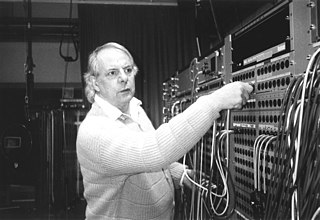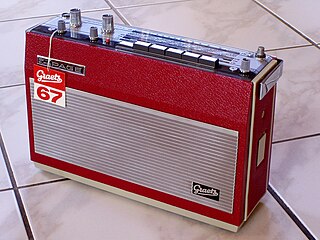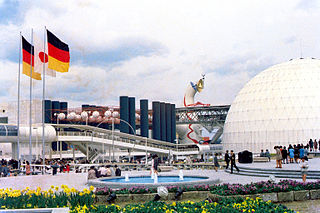
Telemusik is an electronic composition by Karlheinz Stockhausen, and is number 20 in his catalog of works.

Telemusik is an electronic composition by Karlheinz Stockhausen, and is number 20 in his catalog of works.
Through his composition student, Makoto Shinohara, Stockhausen was invited by the Japan Broadcasting Corporation NHK to visit Tokyo, and to carry out two commissions in their electronic music studio, in connection with the 50th anniversary of the founding of NHK in 1965. Because of other commitments, Stockhausen was unable to meet this schedule but finally, under pressure from Tokyo, he flew to Japan on 19 January 1966. [1] According to a note in the score,
Telemusik was realized between January 23 and March 2, 1966 in the Studio for Electronic Music of the Japanese broadcasting system Nippon Hoso Kyokai (NHK), in collaboration with the director of the studio, Wataru Uenami and the studio technicians Hiroshi Shiotani, Shigeru Satô and Akira Honma. [2]
The score is dedicated to the Japanese people. The first public performance took place at the NHK studios in Tokyo on 25 April 1966, in a program which also featured the first and second performances (in versions for trombone and for flute) of Stockhausen's other NHK commission, Solo . [3]
The substance of the work consists of recordings of a variety of traditional ethnic musics from around the world, together with electronically generated sounds. [4] More than twenty of these recorded fragments are intermodulated on tape with electronic sounds and with each other to produce "odd hybrid-types"—modulating, for example, "the chant of monks in a Japanese temple with Shipibo music from the Amazon, and then further impos[ing] a rhythm of Hungarian music on the melody of the monks. In this way, symbiotic things can be generated, which have never before been heard". [5] Only seven of the work's thirty-two moments—nos. 1, 2, 4, 6, 8, 10, and 16—are restricted entirely to electronic sounds. [6] The pitch range is deliberately kept rather high, between 6 and 12 kHz, so that the intermodulation can occasionally project sounds downwards, sections "that seem to be so far away because the ear cannot analyse it, so that it entered the normal audible range and suddenly became understandable". In this way, register becomes a means of bringing the “distant” close up (Greek tele, "afar, far off", as in "telephone" or "television") the concept from which the title of the work is derived. [7]
The work was created using a six-track tape recorder custom-built for the NHK studios. One track was reserved for editing during production, with the completed music being intended for playback in five channels, arranged in a circle around the audience. However, there are none of the continually-moving-sound techniques found in other of Stockhausen's electronic works, such as Kontakte , Sirius , or Oktophonie from Dienstag aus Licht . The spatial conception of Telemusik is therefore closer to that of Gesang der Jünglinge , which was also originally in five channels. For performances elsewhere than at the NHK studios, Stockhausen mixed down several two-channel stereo copies, using a panorama console to approximately position the five channels from left to right as I IV III II V. [8]


The principal forming element of Telemusik is duration. [9] The work consists of thirty-two structures, called "moments" by the composer. [10] Each begins with the stroke of a Japanese temple instrument. These six instruments are each associated with a moment duration according to their natural decay time: the taku (a high-pitched sandalwood clapper with almost instantaneous decay) with the shortest duration, the bokushō (a larger clapper with longer decay time) with the next longer duration, then a hollow-sounding mokugyo ("wooden fish"), higher and lower-pitched cup gongs called rin and keisu, ending with a group of four large temple bells for the longest of the six durations used. [11] The durations in seconds of these moments are taken from the six Fibonacci numbers between 13 and 144. The numbers of occurrences of these steps are also drawn from Fibonacci numbers, from 1 to 13. [12] [9] The longer the step, the fewer times it occurs, and vice versa:
144 × 1
89 × 2
55 × 3
34 × 5
21 × 8
13 × 13
However, the actual duration values used in the score are systematically varied above these base values so that from longest to shortest there are 1, 2, 3, 4, 3, and 2 variants (144, 89/91, 55/56/57, 34/35/36/37, 21/22/23, and 13/14). In order to achieve the specified numbers of moments, the variants of the shorter values are duplicated, again according to the Fibonacci series (13 × 5, 14 × 8; 21 × 3, 22 × 3, 23 × 2; 34 × 2, and the rest with single instances). [13]
| identifying instrument | duration (secs.) | no. of occurrences | total durations (secs.) |
| temple bells | 144 | 1 | 144 |
| keisu | 89/91 | 1 + 1 = 2 | 180 |
| rin | 55/56/57 | 1 + 1 + 1 = 3 | 168 |
| mokugyo | 34/35/36/37 | 2 + 1 + 1 + 1 = 5 | 176 |
| bokushō | 21/22/23 | 3 + 3 + 2 = 8 | 175 |
| taku | 13/14 | 5 + 8 = 13 | 177 |

Each of the 32 moments is then subdivided into from two to thirteen subsections, again using Fibonacci numbers, in most cases with some values repeated. For example, one of the composer's sketches (reproduced in Erbe 2004 , 146) shows that moment 22, with a total duration of 91 seconds, has subdivisions of 34 + 21 + 13 + 8 + 5 + 3 + 2 + 1 + 2 + 1 + 1, though not used in that order in the composition itself. [14]
The moments' durations are distributed over the length of the composition as follows: [15]
| taku | bokushō | mokugyo | rin | keisu | temple bells | cumulative durations | |
|---|---|---|---|---|---|---|---|
| 1 | 21 | 21 | |||||
| 2 | 13 | 34 | |||||
| 3 | 34 | 68 | |||||
| 4 | 14 | 82 | |||||
| 5 | 22 | 104 | |||||
| 6 | 13 | 117 | |||||
| 7 | 14 | 131 | |||||
| 7 cont'd | 13 + 14 | 158 | |||||
| 8 | 55 | 213 | |||||
| 9 | 35 | 248 | |||||
| 10 | 21 | 269 | |||||
| 11 | 89 | 358 | |||||
| 12 | 13 | 371 | |||||
| 13 | 23 | 394 | |||||
| 14 | 14 | 408 | |||||
| 15 | ↕ | 37 | 445 | ||||
| 16 | ↕ 57 | ↑ | 502 | ||||
| 17 | 22 | ↓ | 524 | ||||
| 18 | 13 | ↕ | 537 | ||||
| 19 | 14 | 551 | |||||
| 20 | 23 | 574 | |||||
| 21 | 36 | 610 | |||||
| 22 | 91 | 701 | |||||
| 23 | 14 | 715 | |||||
| 24 | 56 | 771 | |||||
| 25 | 21 | 792 | |||||
| 26 | 14 | 806 | |||||
| 27 | 34 | 840 | |||||
| 28 | 14 | 854 | |||||
| 29 | 22 | 876 | |||||
| 30 | 14 | 890 | |||||
| 31 | 144 | 1034 | |||||
| 32 | 13 | 1047 |

The "extra" moment marked "7 Fortsetzung" (7 continued) is an insertion which repeats the long composite of descending glissandos from the two preceding moments, ring modulated with a 12,000 Hz sine wave, briefly "notched" with a dip to 2,000 Hz at the point corresponding to the division between moments 6 and 7. This insert is marked at the beginning by a stroke on a Japanese temple instrument found nowhere else in Telemusik: a gong called a kane (鐘). [16] Of the six resulting structural layers, or "formant rhythms" [17] four—the second, third, fourth, and fifth—are internally symmetrical. However, their centres of symmetry, marked in the table by the symbol "↕", do not coincide, so that the composite structure is not itself symmetrical. The keisu layer is centred on the overall form, while the rin, mokugyo, and bokusho layers are phase-shifted by incrementally increasing distances to the left, right, and left again. [11]

Moments are often more or less casually grouped together into successions of two or more moments, similar to the Hauptgruppen Stockhausen conceived as early as Klavierstück I in 1952. [18] Opinions on these groupings differ somewhat. Robin Maconie describes moments 15, 16 and 17 as a "structural episode" consisting of a sustained "resonance of consciousness", superimposing and transforming material taken from moments 1, 4, 5, 6, 7, 9, and 14. [19] [20] Others variously regard as groupings:

Karlheinz Stockhausen was a German composer, widely acknowledged by critics as one of the most important but also controversial composers of the 20th and early 21st centuries. He is known for his groundbreaking work in electronic music, for introducing controlled chance into serial composition, and for musical spatialization.

Licht (Light), subtitled "Die sieben Tage der Woche", is a cycle of seven operas composed by Karlheinz Stockhausen between 1977 and 2003. The composer described the work as an "eternal spiral" because "there is neither end nor beginning to the week." Licht consists of 29 hours of music.
Formula composition is a serially derived technique encountered principally in the music of Karlheinz Stockhausen, involving the projection, expansion, and Ausmultiplikation of either a single melody-formula, or a two- or three-voice contrapuntal construction.
Gruppen for three orchestras (1955–57) is amongst the best-known compositions of German composer Karlheinz Stockhausen, and is Work Number 6 in the composer's catalog of works. Gruppen is "a landmark in 20th-century music ... probably the first work of the post-war generation of composers in which technique and imagination combine on the highest level to produce an undisputable masterpiece".

Kontakte ("Contacts") is an electronic music work by Karlheinz Stockhausen, realized in 1958–60 at the Westdeutscher Rundfunk (WDR) electronic-music studio in Cologne with the assistance of Gottfried Michael Koenig. The score is Nr. 12 in the composer's catalogue of works, and is dedicated to Otto Tomek.
Intuitive music is a form of musical improvisation based on instant creation in which fixed principles or rules may or may not have been given. It is a type of process music where instead of a traditional music score, verbal or graphic instructions and ideas are provided to the performers. The concept was introduced in 1968 by the German composer Karlheinz Stockhausen, with specific reference to the collections of text-notated compositions Aus den sieben Tagen (1968) and Für kommende Zeiten (1968–70). The first public performance of intuitive-music text compositions, however, was in the collective work Musik für ein Haus, developed in Stockhausen's 1968 Darmstadt lectures and performed on 1 September 1968, several months before the first realisations of any of the pieces from Aus den sieben Tagen.

Hymnen is an electronic and concrete work, with optional live performers, by Karlheinz Stockhausen, composed in 1966–67, and elaborated in 1969. In the composer's catalog of works, it is No. 22.

Montag aus Licht is an opera by Karlheinz Stockhausen in a greeting, three acts, and a farewell, and was the third of seven to be composed for the opera cycle Licht: die sieben Tage der Woche. The libretto was written by the composer.

Kurzwellen, for six players with shortwave radio receivers and live electronics, is a composition by Karlheinz Stockhausen, written in 1968. It is Number 25 in the catalog of the composer's works.

Samstag aus Licht is an opera by Karlheinz Stockhausen in a greeting and four scenes, and was the second of seven to be composed for the opera cycle Licht: die sieben Tage der Woche. It was written between 1981 and 1983, to a libretto written by the composer and incorporating a text by Saint Francis of Assisi, and was first staged in Milan in 1984.

Donnerstag aus Licht is an opera by Karlheinz Stockhausen in a greeting, three acts, and a farewell, and was the first of seven to be composed for the opera cycle Licht: die sieben Tage der Woche. It was written between 1977 and 1980, with a libretto by the composer.

Dienstag aus Licht is an opera by Karlheinz Stockhausen in a greeting and two acts, with a farewell, and was the fourth of seven to be completed for the opera cycle Licht: Die sieben Tage der Woche. It was begun in 1977 and completed from 1988 to 1991, to a libretto by the composer.

Spiral, for a soloist with a shortwave receiver, is a composition by Karlheinz Stockhausen, written in 1968. It is Number 27 in the catalogue of the composer's works.

Zeitmaße is a chamber-music work for five woodwinds composed in 1955–1956 by German composer Karlheinz Stockhausen; it is Number 5 in the composer's catalog. It is the first of three wind quintets written by Stockhausen, followed by Adieu für Wolfgang Sebastian Meyer (1966) and the Rotary Wind Quintet (1997), but is scored with cor anglais instead of the usual French horn of the standard quintet. Its title refers to the different ways that musical time is treated in the composition.

Mixtur, for orchestra, 4 sine-wave generators, and 4 ring modulators, is an orchestral composition by the German composer Karlheinz Stockhausen, written in 1964, and is Nr. 16 in his catalogue of works. It exists in three versions: the original version for full orchestra, a reduced scoring made in 1967, and a re-notated version of the reduced scoring, made in 2003 and titled Mixtur 2003, Nr. 162⁄3.

Pole (Poles), for two performers with shortwave radio receivers and a sound projectionist, is a composition by Karlheinz Stockhausen, written in 1970. It is Number 30 in the catalogue of the composer's works.
Spatial music is composed music that intentionally exploits sound localization. Though present in Western music from biblical times in the form of the antiphon, as a component specific to new musical techniques the concept of spatial music was introduced as early as 1928 in Germany.

Oktophonie (Octophony) is a 1991 octophonic electronic-music composition by Karlheinz Stockhausen. A component layer of act 2 of the opera Dienstag aus Licht, it may also be performed as an independent composition. It has a duration of 69 minutes.
Unsichtbare Chöre is an eight-channel electronic-music composition by Karlheinz Stockhausen. A component part of the opera Donnerstag aus Licht, it may also be performed as an independent composition, in which form it is designated "ex 49" in the composer's catalog of works.

Expo, for three performers with shortwave radio receivers and a sound projectionist, is a composition by Karlheinz Stockhausen, written in 1969–70. It is Number 31 in the catalogue of the composer's works.
Sources